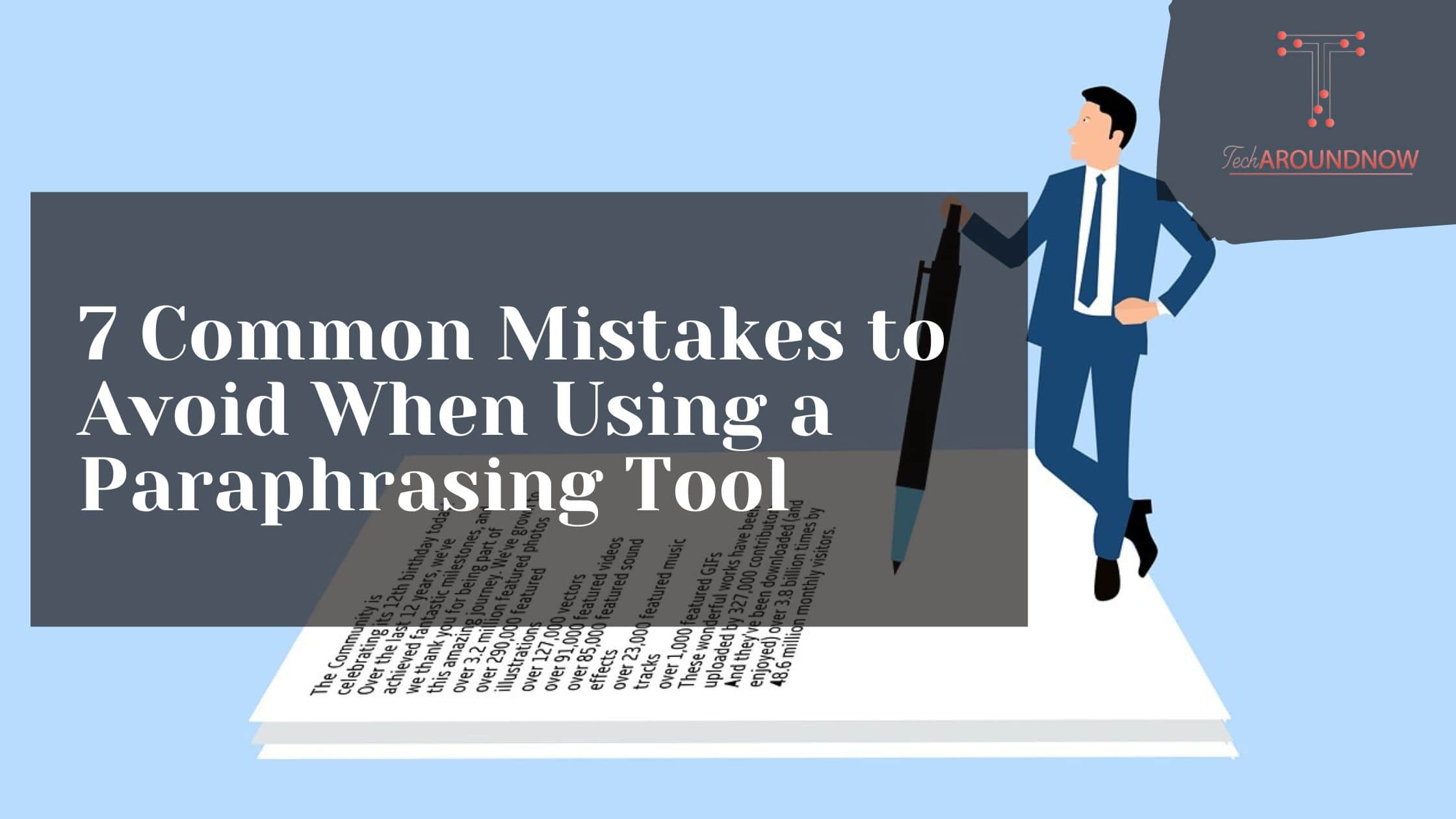While such tools can be incredibly helpful for streamlining your writing process, it’s crucial to avoid common pitfalls that turn them from allies into adversaries. And now, we are about to see 7 mistakes to steer clear of.
What are The 7 Common Mistakes to Avoid When Using a Paraphrasing Tool?
It’s certain that paraphrasing tools can be valuable assets in the writer’s toolkit to create amazing content, but their improper use can lead to unintended consequences.
To ensure the integrity and originality of your work, here are seven crucial mistakes to avoid when using a paraphrasing tool:
1. Blind Acceptance: Question the Machine’s Gospel
While usually paraphrasing tools offer valuable suggestions you can leverage, it’s crucial to remember they aren’t perfect and shouldn’t be blindly accepted.
Think of paraphrasing tools as helpful whispers offering alternative options, not pronouncements from infallible oracles.
Meaning, that you just don’t simply adopt their suggestions on autopilot. Instead, meticulously evaluate each one. Does it retain the original meaning while flowing smoothly within your context? Does it avoid awkward phrasing that disrupts the natural rhythm of your writing?
Approach these tools as starting points, not gospel truths. Why this cautious approach? Despite their sophistication, these tools are algorithms susceptible to errors. Synonyms might not capture the precise nuance, and sentence structures can get lost in translation.
Additionally, paraphrasing tools often lack the ability to grasp the subtle flow of your writing or the specific demands of your context.
Their suggestions, while sometimes helpful, can introduce clunkiness or disrupt the natural rhythm of your prose. Therefore, be your own discerning editor. Scrutinize each suggestion meticulously.
2. Citation Conundrum: Give Credit Where Credit is Due
Don’t be fooled by the illusion of originality with paraphrasing tools. Even when you express ideas in your own words, the source still deserves proper recognition.
Omitting citations isn’t just intellectual laziness, it’s plagiarism – a serious ethical and academic transgression. Every rephrased snippet, every borrowed idea, requires a citation. Accordingly, treat it as a non-negotiable part of your writing process.
Think of source tracking as detective work. Then, transform into a “Citation Champion,” wielding the citation style guide of your field to craft accurate and appropriate references. This might seem tedious, but remember, “Integrity Matters.”
Every citation has to shine a light on the foundation of your work, showcasing your respect for intellectual property and solidifying your credibility. It’s the difference between building trust and raising red flags.
So, give credit where it’s due, not just for ethical reasons, but to establish yourself as a writer of true academic integrity.
3. Over-Reliance: Tools are Assistants, Not Replacements
Sure some paraphrasing tool can be tempting shortcuts, but beware of becoming overly reliant on them. Use them as training wheels for your writing bike – helpful for short bursts, but ultimately hindering your progress if used excessively.
Leaning too heavily on these tools can stunt your ability to develop your paraphrasing skills, vocabulary, and sentence construction, leading to monotonous, uninspired writing that lacks your unique voice.
In short, these tools are meant to assist, not automate. They can’t replace the critical thinking necessary to understand the text, its context, and your intended message. Instead, use them strategically:
- Targeted Assistance: When you encounter specific challenges like finding synonyms or restructuring sentences, employ the tool for that specific issue, not as a blanket solution.
- Fuel for Creativity: View their suggestions as springboards to spark your own creativity. Use them to brainstorm paraphrases that are both accurate and original, infused with your own voice and style.
- Sharpen Your Saw: Don’t neglect traditional methods like reading widely, actively building your vocabulary, and practicing paraphrasing on your own. These are the cornerstones of long-term writing development.
True mastery comes from understanding, not automation. Use these tools to enhance your skills, not replace them. Your unique voice is the engine that drives truly compelling writing.
4. Proofreading Paranoia: Trust, but Verify
While paraphrasing tools offer exciting possibilities, let’s not fall into the “proofread by machine, perfect forever” trap.
Even the most advanced tools can make mistakes – typos, grammatical errors, factual inaccuracies, or unintentional changes in meaning. A single misstep can turn even the most elegant paraphrase into a confusing mess.
Meaning, before hitting publish, remember: vigilance is your superpower. Think of yourself as the final quality control inspector. Here’s why:
- A glitch in the Matrix: Technology may glitch, introducing typos, grammatical errors, or nonsensical sentences. Be your own hawk-eyed proofreader, scrutinizing every sentence for clarity and correctness.
- Factual Faux Pas: Double-check facts and figures, especially in sensitive or technical topics. The tool might not have your specific knowledge base, so fact-checking becomes your responsibility.
- Meaning Mishap: Subtle nuances can get lost in translation. Meticulously compare the original and paraphrased text to ensure the intended message remains crystal clear.
Proofread with passion, fact-check with fury, and compare with care. As we all know, technology is a powerful tool, but it’s not perfect.
Your critical eye is essential to catch errors and ensure your message shines through with originality and confidence. By wielding your vigilance, you can transform paraphrasing tools from potential pitfalls into allies, empowering you to write with clarity and impact.
Regardless, the magic lies not in the click of a button, but in the power of your unique voice and critical thinking.
5. Contextual Catastrophe: Meaning Lost in Translation
Don’t let paraphrasing tools become context-oblivious robots mangling your message! While they offer suggestions, remember meaning isn’t just about individual words. It’s a beautiful mosaic crafted by surrounding text, target audience, and overall tone.
Accepting a seemingly perfect paraphrase without considering these elements can create jarring clashes and confuse your readers.
You have to consider paraphrasing tools like paintbrushes, not artists: they provide colors, but you need to paint the whole picture. Here’s why context matters:
- Meaning Mosaic: A sentence’s true meaning is woven from its surroundings, its audience, and the overall tone. A funny quip in a research paper is like a polka dot on a tuxedo – out of place.
- Lost in Translation: What works in isolation might create dissonance in context. Imagine using slang in a formal presentation!
- Audience Awareness: Your language should adapt to your audience. A child wouldn’t understand medical jargon, and a scientist wouldn’t need overly simplified explanations.
Be your own maestro, conducting the context:
- Zoom Out, Then Zoom In: Analyze how the suggestion fits within the broader context. Does it maintain the tone and style? Does it serve your purpose for that specific audience?
- Target in Sight: Consider your audience’s expectations and knowledge level. Adapt the language and complexity accordingly.
- Harmony, Not Discord: Ensure the paraphrased text flows seamlessly, avoiding awkward transitions or confusing shifts in tone.
6. Synonym Spree: Beyond the Thesaurus Trap
Forget the thesaurus trap! True paraphrasing is about weaving magic, not just swapping words. While synonyms might seem like a handy shortcut, they often leave your writing flat and forgettable. Here’s why:
Firstly, synonyms often miss the subtle shades of meaning and context that make your writing sing. They’re like a paint-by-numbers kit, creating a generic picture instead of your unique masterpiece.
Secondly, the overuse of synonyms leads to repetitive, monotonous writing that sounds more like a robot than you. Beyond everything, your voice matters!
Instead, aim for organic expression be it in subtitles or captioning. Restructure sentences, play with their order, and even combine them to create a natural flow that reflects your thinking. In short, don’t be afraid to experiment! Think beyond the individual word.
And most importantly, infuse your paraphrases with your own style and personality. Don’t let the tool dictate your tone or voice. Be you, be bold, be original!
Effective paraphrasing always is about crafting a new expression, not just changing a few words. It’s about capturing the essence of the original while adding your own unique flair.
So use these tools as inspiration, not a crutch. Get to ditch the thesaurus, unleash your creativity, and start writing like the amazing writer you are.
7. Originality Amnesia: Remember Your Voice
Last but not least, don’t become a victim of “Paraphrasing Amnesia”! While tools can suggest alternatives, never surrender your own voice.
Remember, you’re the chef, not the recipe book. Leaning too heavily on tools risks creating ghostwritten text that lacks your unique perspective and insights. It’s like wearing someone else’s clothes – sure, they might fit, but they don’t express your true essence.
Comprehend paraphrasing as solving a puzzle. Use the tool’s suggestions as pieces, but engage your critical thinking to craft a solution that reflects your intended message and context. Don’t fall into a passive “copy-paste” mode.
Don’t forget it’s your interpretation and analysis that bring depth and meaning to the text. Remember the magic ingredient: YOU!
Infuse your paraphrases with your unique voice and perspective. It’s like adding your own spices to a recipe – the base ingredients might be similar, but your personal touch creates a dish that’s distinctly yours.
Conclusion
While paraphrasing tools can be valuable assets, their true power lies in responsible use. Avoid common pitfalls like over-reliance, inaccuracy, and plagiarism.
Paraphrasing tools are used to enhance your writing, not shortcuts to replace it. S embrace your originality, wield the tools wisely, and craft content that shines with your unique voice.
Besides, cite ethically, experiment with strategies, and keep learning to refine your skills. Likewise write with confidence – the tools are there to empower, not replace, your inner wordsmith.
Through understanding the nuances of language and embracing your individual voice, you can transform paraphrasing tools from basic word changers into powerful allies that help you write with clarity, originality, and depth.
Remember, paraphrasing tools are there to assist, not replace, your critical thinking and writing skills. Use them wisely, but always maintain your role as the ultimate author.
TechAroundNow is a blogging website that centers on the latest technology and marketing innovations and trends, aimed at assisting individuals and businesses across the globe since 2021. TechAroundNow continues to serve as a reliable source for staying up-to-date with the ever-evolving landscape of technology and marketing, ultimately fostering growth and success in the digital era.


